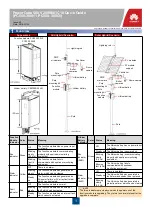
NOTE: It is our policy to continually improve products and as such we reserve the right to alter data, specifications and component parts without prior notice.
IMpORTANT:
no liability is accepted for incorrect use of this product.
WARRANTY:
Guarantee is 12 months from purchase date, proof of which will be required for any claim.
INFORMATION:
For a copy of our latest catalogue and promotions call us on 01284 757525 and leave your full name and address, including postcode.
01284 757500
01284 703534
Sole UK Distributor, Sealey Group,
Kempson Way, Suffolk Business Park
,
Bury St. Edmunds, Suffolk,
IP32 7AR
www.sealey.co.uk
Web
Environmental protection.
Recycle unwanted materials instead of disposing of them as waste. All tools, accessories and packaging should
be sorted, taken to a recycle centre and disposed of in a manner which is compatible with the environment.
When the product is no longer required, it must be disposed of in an environmentally protective way.
Contact your local solid waste authority for recycling information.
Battery Removal.
undo the 5 cross head screws in the handle, and split the 2 halves of the handle revealing the battery compartment.
Remove the battery by cutting the wires. Dispose of the battery according to local authority guidelines.
under the Waste Batteries and Accumulators Regulations 2009, Jack Sealey Ltd are
required to inform potential purchasers of products containing batteries (as defined within these regulations),
that they are registered with Valpak’s registered compliance scheme.
Jack Sealey Ltd’s Batteries Producer Registration number (BPRn) is BPRn00705
Li-Ion
IMpORTANT WARRANTY INFORMATION:
The battery fitted to this cordless tool is considered to be a
consumable item and its ability to accept charge will reduce
over time. We will warranty it against mechanical and electrical
defect for a period of one year - this does not cover fair wear
and tear. If the battery is not properly charged before first use, or
regularly conditioned, its capacity will diminish. under these
circumstances we will not replace the battery even if it is less
than one year old.
3.1.
To charge the screwdriver, insert the charger jack into the
charging socket on the screwdriver (fig.1) and plug the charger
into a mains socket.
3.2.
The red LED will illuminate to indicate the battery is being
charged. When charging is complete, unplug the charger from
the mains and the screwdriver.
3.3.
Place a bit into the bit holder of the screwdriver. Select the
required direction by using the reverse switch (which will lock
the screwdriver in it's central position) and squeeze the power
trigger to start the screwdriver.
3.4.
If the work area is dark, press the LED switch on the side of
the screwdriver to activate the LED worklight (fig.2).
3.5.
To check the condition of the battery, press and hold down the
battery indicator button next to the battery level indicator (fig.1).
If all LEDs illuminate, there is sufficient charge, if just the yellow
and red LEDs illuminate, the screwdriver will soon need
charging, if just the red LED illuminates, the screwdriver needs
to be charged immediately.
3.6.
To change the position of the handle, press the handle release
and turn the handle around 180° until it clicks into position.
3.7.
To select torque or drill setting, twist the torque selector around
to the required setting - from 1 (the lowest) to 6 (the highest) for torque setting or to the drill symbol for drilling.
3.8.
When finished working, remove the bit from the bit holder, pulling back the quick release bit holder if needed. Clean the screwdriver
and replace all parts in the storage case. Store the case in a safe, dry, child proof location.
3. OpERATION
Original Language Version
CP36S Issue: 3 - 13/01/12
Risk of Hand Arm Vibration Injury
3.6V Li-ion cordless screwdriver set Model no. CP36S when operated in accordance with these instructions and tested in
accordance with BS En 28662-1:1993, ISo 8662-1:1988 and BS En ISo 8662-7:1997 results in the following vibration emission
declared in accordance with BS En 12096:1996.
Measured vibration emission value:
0.153m/s²
Uncertainty:
0.06m/s²
These values are suitable for comparison with emission levels of other tools that have been subject to the same test.
This tool may cause hand-arm vibration syndrome if its use is inadequa
tely managed.
This is a ‘
NO LOAD’
vibration figure.
A competent person should carry out a risk assessment following HSE guidelines.
Measurement results can be highly variable, depending on many factors, including the operator's technique, the condition of the
work equipment, the material being processed and the measurement method.
Recommended Measures to reduce risk of hand-arm vibration syndrome:
We recommend appropriate safety equipment is utilised and regular breaks for the operator are employed to reduce any residual
risk of fatigue or repetitive strain injury.
fig.1
fig.2




















